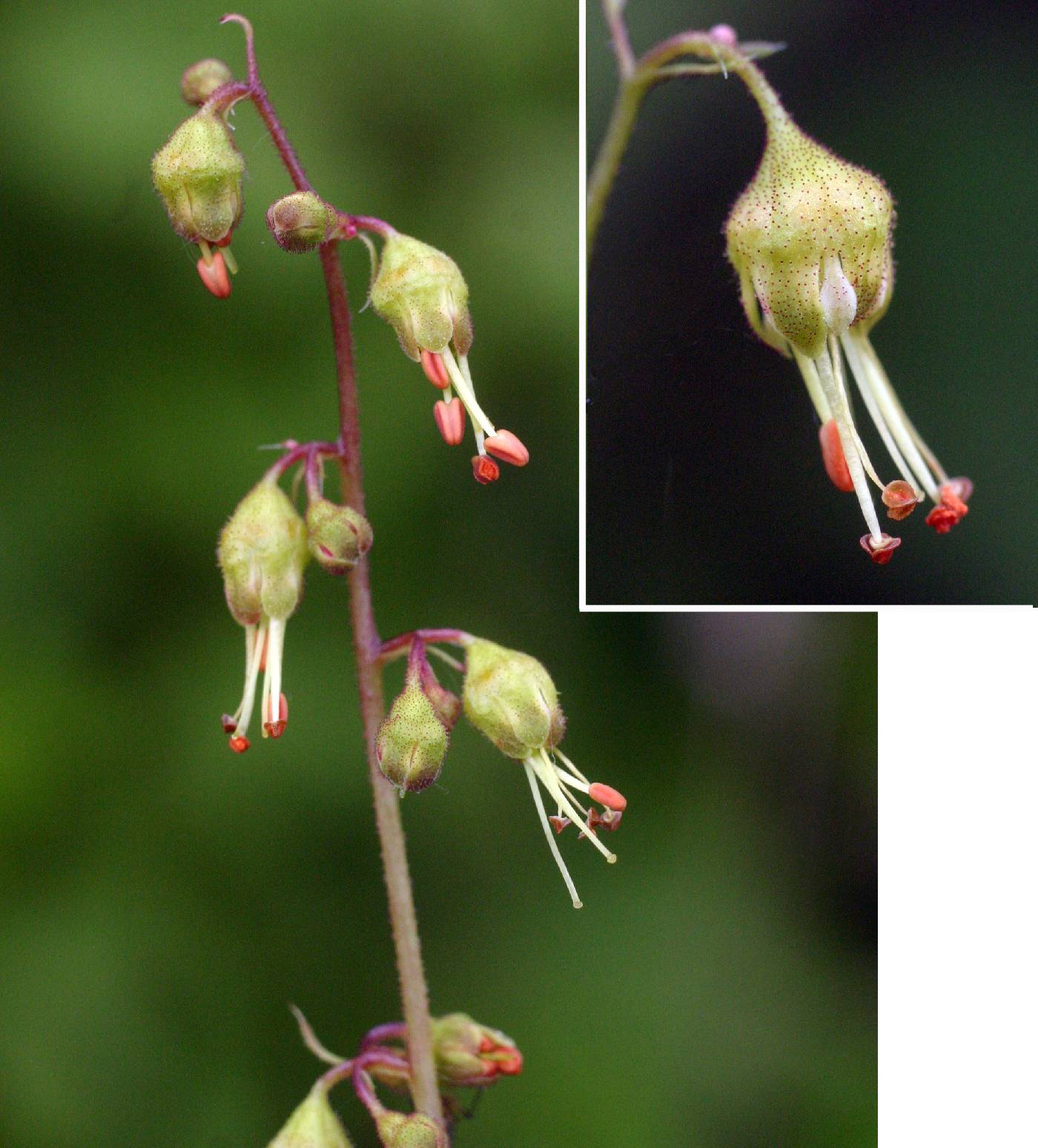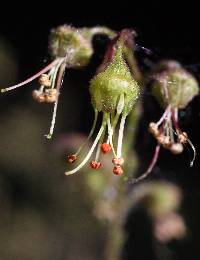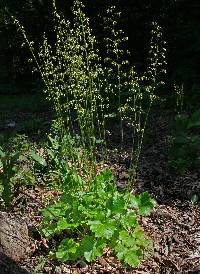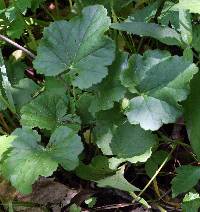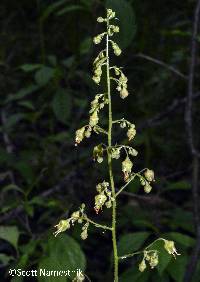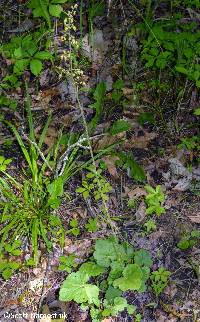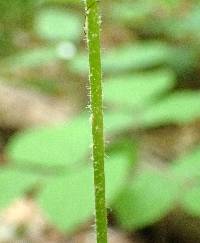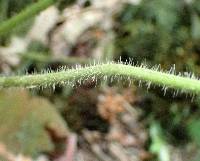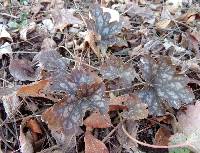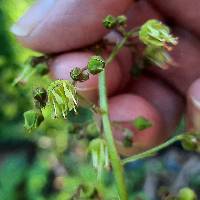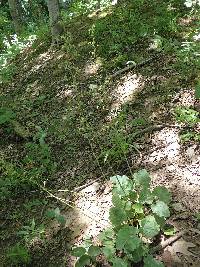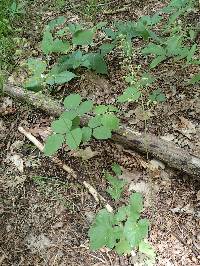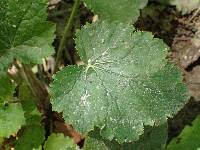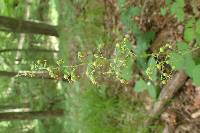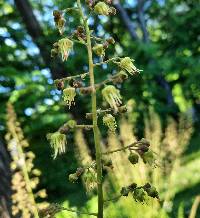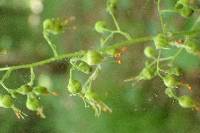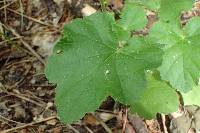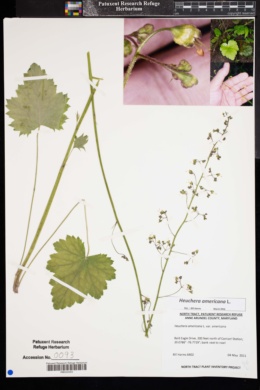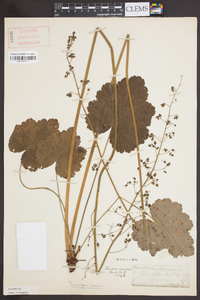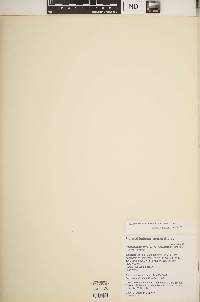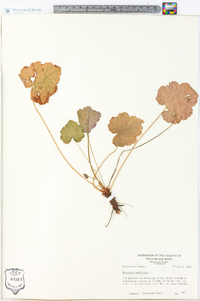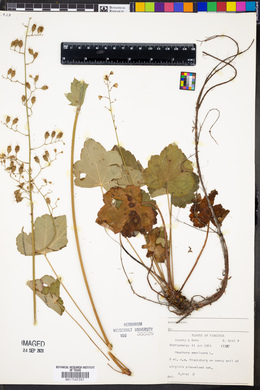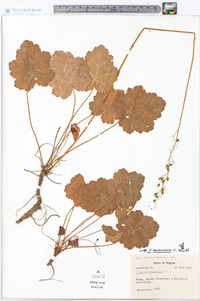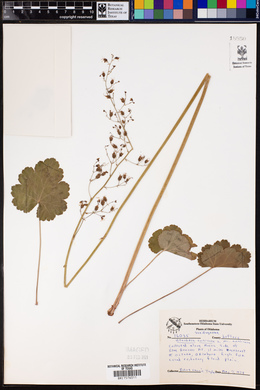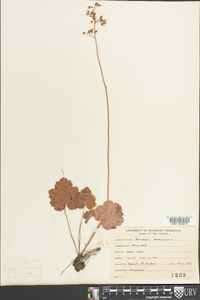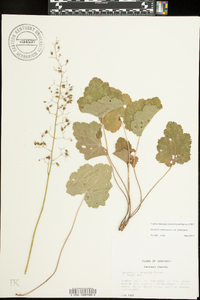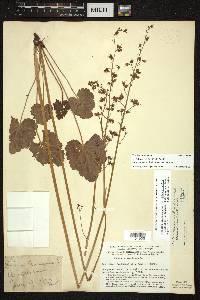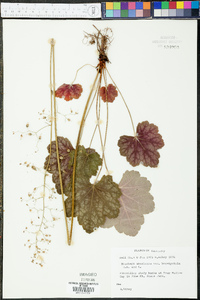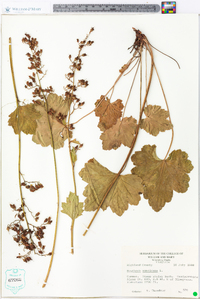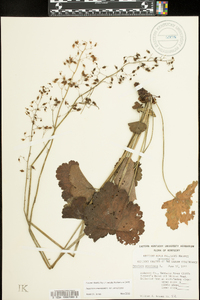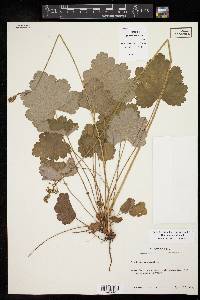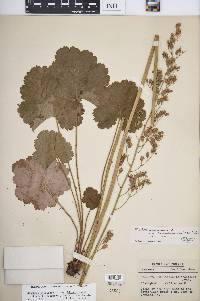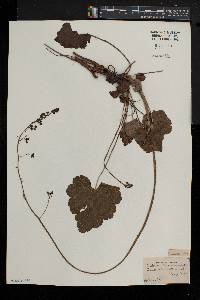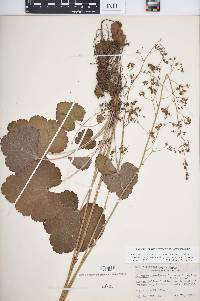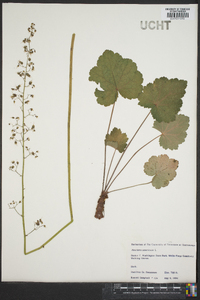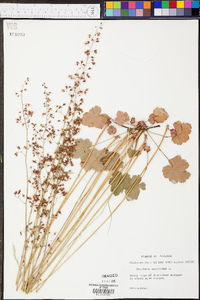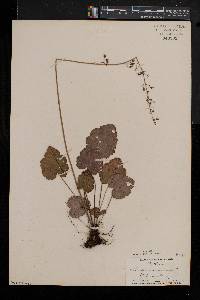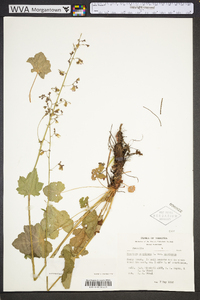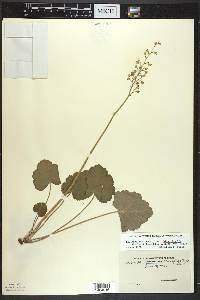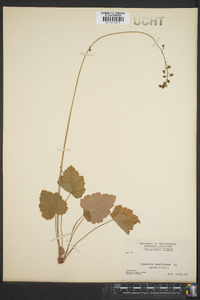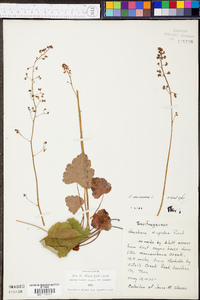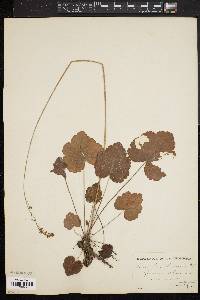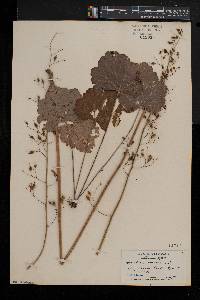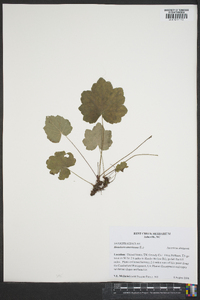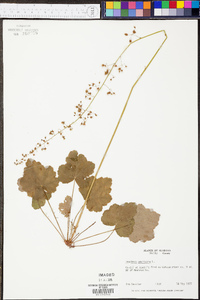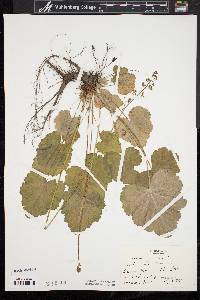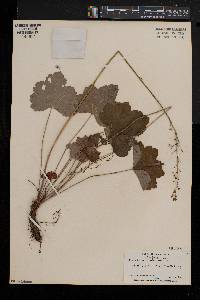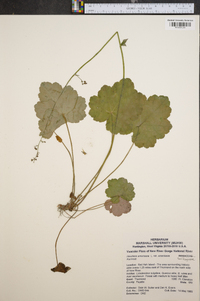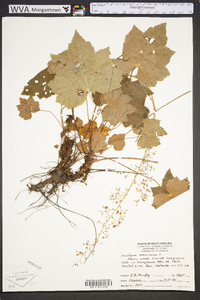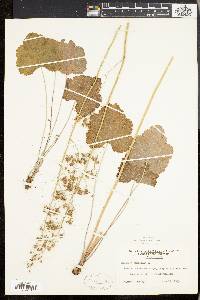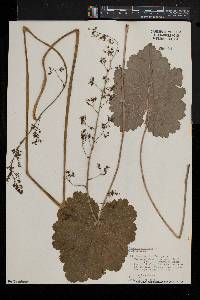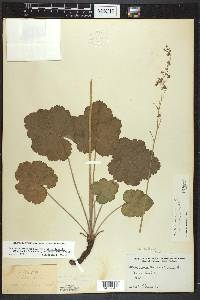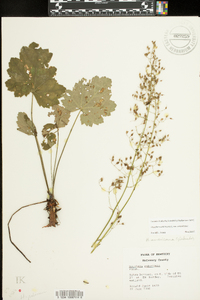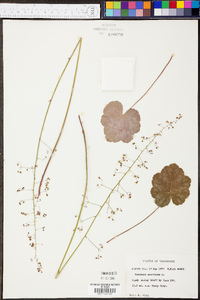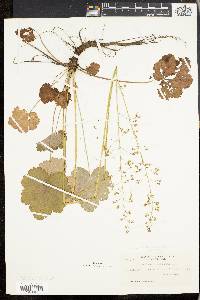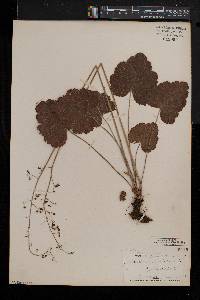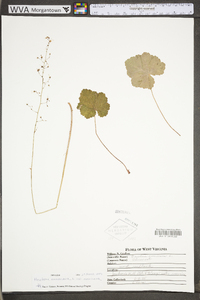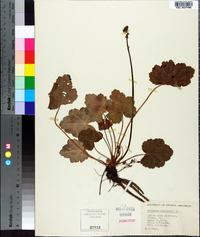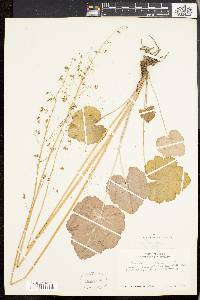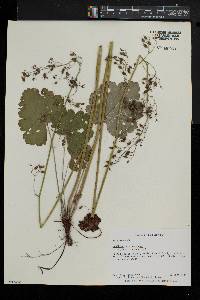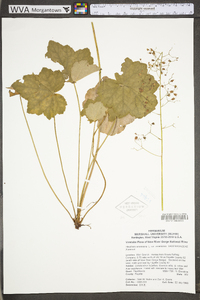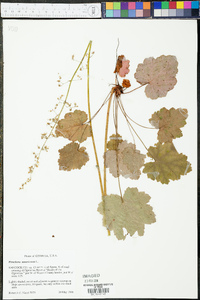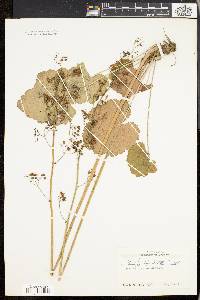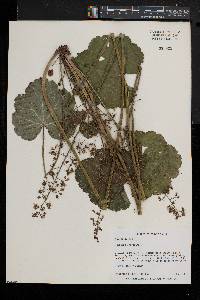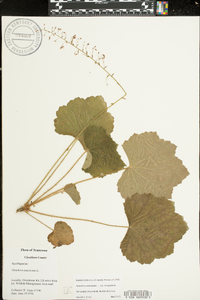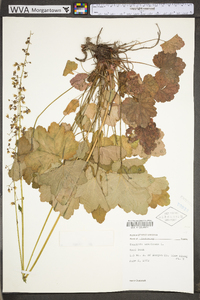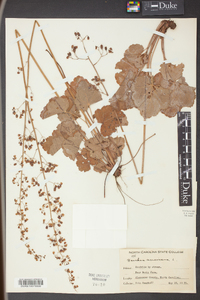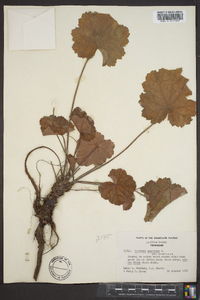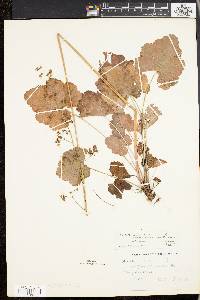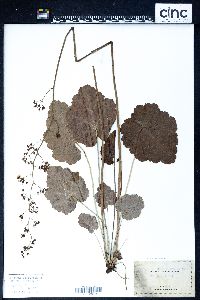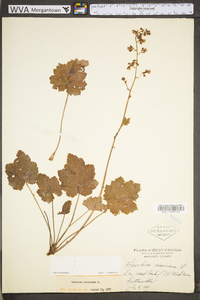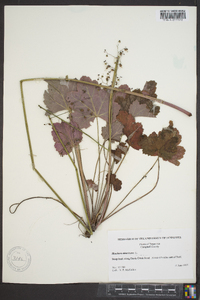
|
|
|
|
Family: Saxifragaceae
American Alumroot
[Heuchera americana f. angustipetala Rosend., Butters & Lakela] |
Herbs acaulescent; caudex branched. Flowering stems leafy, 40-145 cm, glabrous or short stipitate-glandular. Leaves: petiole glabrous or very short to long stipitate-glandular; blade (often variegated adaxially), broadly ovate to cordate, shallowly 5-9-lobed, 3.5-11 cm, base cordate to nearly truncate, lobes rounded or ovate, margins dentate, apex acute or obtuse, surfaces abaxially glabrous or short stipitate-glandular, adaxially glabrous or short stipitate-glandular. Inflorescences diffuse. Flowers: hypanthium weakly bilaterally symmetric, free 0.6-2 mm, green, urceolate or campanulate, abruptly inflated distal to adnation to ovary, 3-7.2 mm, very short stipitate-glandular; sepals erect, green-tipped, equal, 1-2.4 mm, apex rounded; petals erect, greenish, white, pink, or purple, narrowly spatulate, unlobed, 0.9-4 mm, margins entire or finely dentate or fimbriate; stamens exserted 3-5 mm; styles exserted 2.6-6.4 mm, 4-7 mm, to 0.1 mm diam. Capsules ovoid, 4-10.5 mm, beaks divergent, not papillose. Seeds dark brown, ellipsoid, 0.6-0.9 mm. Heuchera americana is highly polymorphic and distributed over a large part of the eastern United States and Canada. Its variability is largely the result of its wide geographic range, the sporadic, semi-isolated distribution of populations, and interaction of differential adaptation and genetic drift made possible by its distribution pattern. Heuchera americana intergrades with both H. pubescens and H. richardsonii where they overlap; the intergrading form with H. pubescens is H. americana var. hispida, and with H. richardsonii it is H. americana var. hirsuticaulis. A breeding study between H. americana, H. pubescens, H. richardsonii, and other species demonstrated ease of artificial hybridization and fertility of offspring among H. americana, H. pubescens, and H. richardsonii (E. F. Wells 1979).
Perennial herb 40 cm - 1.4 m tall Leaves: basal, with a long and hairless to lightly hairy stalk. The blade is green and often white-mottled, 0.4 - 1.5 cm long, deeply heart-shaped to nearly rounded or five-sided, with five to nine rounded or blunt lobes, toothed, hairless to variously hairy. Flowers: borne on loose branches of a narrow inflorescence (panicle), each flower 3 - 5.5 mm long, with the sepals fused into an equal-sided to slightly unequal-sided tube with five lobes. The five spoon- to lance-shaped petals are greenish to white or pink and sometimes have small teeth, the style and five stamens project far past the sepal tube, and the ovary is single-chambered. Fruit: a two-beaked capsule, 5 - 7 mm long, egg-shaped, opening between beaks, containing spiny seeds that are elliptic but with one straight edge. Flowering stem: leafless but with a few small scale-like bracts, hairless to stiffly hairy. Similar species: Heuchera americana var. hirsuticaulis is distinguished from the typical variety by having an unequal-sided sepal tube and stiffly hairy leafstalks. The flowers of Heuchera richardsonii are longer than 5.5 mm and the sepal tube is strongly unequal-sided. Sullivantia sullivantii has up to two leaves on the flowering stem, petals that wither but persist, a two-chambered ovary, and winged seeds. Tiarella cordifolia has an unbranched inflorescence (raceme) with each flower having petals and stamens (ten) that are more conspicuous than the sepals. Each species of Mitella has an unbranched inflorescence (raceme), with each flower having ten stamens, pinnately fringed petals, and an ovary that is somewhat flattened at the top. In addition, Mitella diphylla has two opposite leaves on the flowering stem, while Mitella nuda may have one. Flowering: April to June Habitat and ecology: Rare, usually growing along shaded banks and ravines in the eastern part of the Chicago Region. Occurence in the Chicago region: native Etymology: Heuchera is named after German botanist Johann Heinrich von Heucher (1677 - 1747). Americana means "from America." Author: The Morton Arboretum Plants 4-14 dm; scape with a few small, scale-like bracts; petioles glabrous to minutely glandular-puberulent, seldom with a few longer spreading hairs; lvs often white-mottled, variously hairy or glabrous, 5-9-lobed with lobes of various depths, often pentagonal in outline, the teeth rounded to acute, mucronate; stem glandular in the infl, otherwise glabrous; fls only slightly oblique, 3-7 mm (to the sep-tips), the free part of the hypanthium 0.5-1.5 mm; stamens and style long-exserted; pet spatulate, greenish, white, or pink, entire or with small teeth; 2n=14. Dry upland woods; Conn. to Ga., w. to s. Ont., s. Mich., Ind., s. Ill., and e. Okla. Apr.-June (July). Gleason, Henry A. & Cronquist, Arthur J. 1991. Manual of vascular plants of northeastern United States and adjacent Canada. lxxv + 910 pp. ©The New York Botanical Garden. All rights reserved. Used by permission. |
|
|
|

